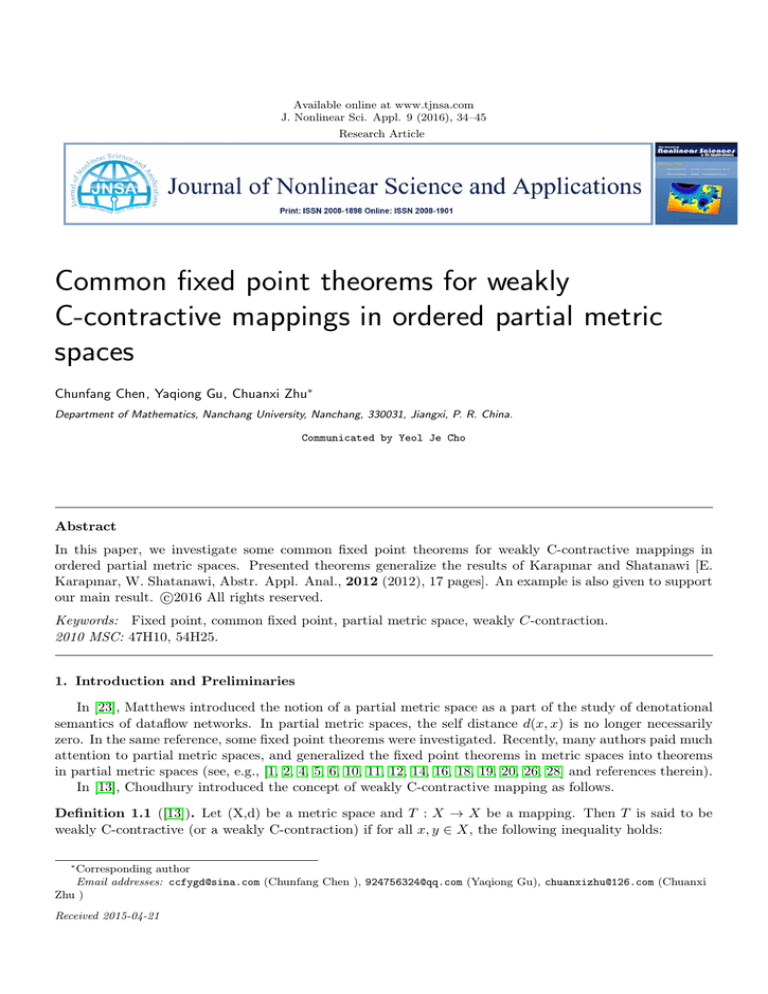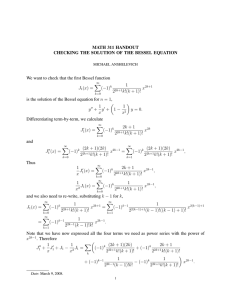
Available online at www.tjnsa.com
J. Nonlinear Sci. Appl. 9 (2016), 34–45
Research Article
Common fixed point theorems for weakly
C-contractive mappings in ordered partial metric
spaces
Chunfang Chen, Yaqiong Gu, Chuanxi Zhu∗
Department of Mathematics, Nanchang University, Nanchang, 330031, Jiangxi, P. R. China.
Communicated by Yeol Je Cho
Abstract
In this paper, we investigate some common fixed point theorems for weakly C-contractive mappings in
ordered partial metric spaces. Presented theorems generalize the results of Karapınar and Shatanawi [E.
Karapınar, W. Shatanawi, Abstr. Appl. Anal., 2012 (2012), 17 pages]. An example is also given to support
c
our main result. 2016
All rights reserved.
Keywords: Fixed point, common fixed point, partial metric space, weakly C-contraction.
2010 MSC: 47H10, 54H25.
1. Introduction and Preliminaries
In [23], Matthews introduced the notion of a partial metric space as a part of the study of denotational
semantics of dataflow networks. In partial metric spaces, the self distance d(x, x) is no longer necessarily
zero. In the same reference, some fixed point theorems were investigated. Recently, many authors paid much
attention to partial metric spaces, and generalized the fixed point theorems in metric spaces into theorems
in partial metric spaces (see, e.g., [1, 2, 4, 5, 6, 10, 11, 12, 14, 16, 18, 19, 20, 26, 28] and references therein).
In [13], Choudhury introduced the concept of weakly C-contractive mapping as follows.
Definition 1.1 ([13]). Let (X,d) be a metric space and T : X → X be a mapping. Then T is said to be
weakly C-contractive (or a weakly C-contraction) if for all x, y ∈ X, the following inequality holds:
∗
Corresponding author
Email addresses: ccfygd@sina.com (Chunfang Chen ), 924756324@qq.com (Yaqiong Gu), chuanxizhu@126.com (Chuanxi
Zhu )
Received 2015-04-21
C. Chen, Y. Gu, C. Zhu, J. Nonlinear Sci. Appl. 9 (2016), 34–45
35
1
d(T x, T y) ≤ (d(x, T y) + d(T x, y)) − φ(d(x, T y), d(T x, y)),
2
where φ : [0, +∞) × [0, +∞) → [0, +∞) is a continuous function such that φ(x, y) = 0 if and only if
x = y = 0.
After that, some results have appeared related to weakly C-contractive mappings (see, for example,
[8, 9, 15, 27]). Karapınar and Shatanawi [20] introduced the weakly (C, ψ, φ)-contractive mappings and
investigated fixed point theorems for such mappings in ordered partial metric spaces.
Definition 1.2 ([20]). Let (X, ) be a partially ordered set and p be a partial metric on X. Then the
mappings S, T : X × X → X are said to be weakly (C, ψ, φ)-contractive mappings if T and S are weakly
increasing with respect to and for any comparable x and y, we have
p(T x, y) + p(x, Sy)
ψ(p(T x, Sy)) ≤ ψ
− φ(p(T x, y), p(x, Sy)),
2
where
(a) ψ : [0, +∞) → [0, +∞) is an altering distance function;
(b) φ : [0, +∞) × [0, +∞) → [0, +∞) is a continuous function with φ(t, s) = 0 if and only if t = s = 0.
Some concepts in the Definition 1.2 will be introduced in the next section.
For weakly (C, ψ, φ)-contractive mappings, Karapınar and Shatanawi obtained some results in [20].
Theorem 1.3 ([20]). Let (X, ) be a partially ordered set and suppose that there exists a partial metric p on
X such that (X, p) is complete. Suppose that T, S : X × X → X are weakly (C, ψ, φ)-contractive mappings.
If T and S are continuous, then T and S have a common fixed point; that is, there exists u ∈ X such that
u = T u = Su.
Definition 1.4 ([20]). X is called to satisfy property (P ) if {xn } is a nondecreasing sequence in X such
that lim p(xn , x) = p(x, x), then xn ≤ x for all n ∈ N .
n→+∞
Theorem 1.5 ([20]). Let (X, ) be a partially ordered set and suppose that there exists a partial metric p on
X such that (X, p) is complete. Suppose that T, S : X × X → X are weakly (C, ψ, φ)-contractive mappings.
If X satisfies property (P ), then T and S have a common fixed point; that is, there exists u ∈ X such that
u = T u = Su.
In this paper, we investigate some common fixed point theorems for weakly C-contractive mappings in
ordered partial metric spaces. Our results generalize and extend the results in [20]. Throughout this paper,
the letters N , N + and R+ will denote the set of all nonnegative integer numbers, the set of all positive
integer numbers and the set of all nonnegative real numbers, respectively.
Let us recall some definitions and some properties of partial metric spaces which will be needed in the
sequel.
Definition 1.6 ([23]). A partial metric on a nonempty set X is a function p : X × X → R+ such that for
all x, y, z ∈ X:
(P1 )
(P2 )
(P3 )
(P4 )
x = y ⇔ p(x, y) = p(x, x) = p(y, y),
p(x, x) ≤ p(x, y),
p(x, y) = p(y, x),
p(x, y) ≤ p(x, z) + p(z, y) − p(z, z).
C. Chen, Y. Gu, C. Zhu, J. Nonlinear Sci. Appl. 9 (2016), 34–45
36
A partial metric space is a pair (X, p) such that X is a nonempty set and p is a partial metric on X.
It is clear that, if p(x, y) = 0, then from (P1 ) and (P2 ), x = y. But if x = y, p(x, y) may not be 0.
For a partial metric p on X, the function dp : X × X → [0, +∞) given by
dp (x, y) = 2p(x, y) − p(x, x) − p(y, y)
is an usual metric on X. Each partial metric p on X generates a T0 topology τp on X with a base of the
family of open p-balls {Bp (x, ε) : x ∈ X, ε > 0}, where Bp (x, ε) = {y ∈ X : p(x, y) < p(x, x) + ε} for all
x ∈ X and ε > 0.
In a partial metric space, the concepts of convergence, completeness and continuity are defined as follows.
Definition 1.7 ([22, 23]). Let (X, p) be a partial metric space. Then:
(i) A sequence {xn } in a partial metric space (X, p) converges to a point x ∈ X if and only if
p(x, x) = lim p(x, xn ).
n→+∞
(ii) A sequence {xn } in a partial metric space (X, p) is called a Cauchy sequence if there exists (and is
finite) lim p(xm , xn ).
n,m→+∞
(iii) A partial metric space is called complete if every Cauchy sequence {xn } in X converges with respect
to τp to a point x ∈ X such that p(x, x) = lim p(xm , xn ).
n,m→+∞
(iv) A mapping T : X → X is said to be continuous at x0 ∈ X if for every ε > 0, there exists δ > 0 such
that T (Bp (x0 , δ)) ⊂ Bp (T x0 , ε).
The following lemmas play an important role in the proof of our main results.
Lemma 1.8 ([3]). Let (X, p) be a partial metric space.
(A) A sequence {xn } is a Cauchy sequence in a partial metric space (X, p) if and only if {xn } is a Cauchy
sequence in a metric space (X, dp ).
(B) A partial metric space (X,p) is complete if and only if the metric space (X, dp ) is complete. Moreover,
lim dp (xn , x) = 0 ⇔ P (x, x) = lim p(xn , x) =
n→+∞
n→+∞
lim
n,m→+∞
p(xn , xm ).
(1.1)
Lemma 1.9 ([3, 17]). Assume that xn → z as n → +∞ in a partial metric space (X, p) such that p(z, z) = 0.
Then lim p(xn , y) = p(z, y) for every y ∈ X.
n→+∞
Lemma 1.10 ([24]). Let (X, p) be a partial metric space and let {xn } be a sequence in X such that
lim p(xn+1 , xn ) = 0.
n→+∞
If {x2n } is not a Cauchy sequence in (X, p), then there exists ε > 0 and two sequences {m(k)} and {n(k)}
of positive integers such that n(k) > m(k) > k and the following four sequences tend to ε when k → +∞:
p(x2m(k) , x2n(k) ), p(x2m(k) , x2n(k)+1 ), p(x2m(k)−1 , x2n(k) ), p(x2m(k)−1 , x2n(k)+1 ).
(1.2)
Lemma 1.11 ([20, 24]). Let (X, p) be a partial metric space, T : X → X be a given mapping. Suppose that
T is continuous at x0 ∈ X. Then, for each sequence {xn } in X, xn → x0 in τp ⇒ T xn → T x0 in τp holds.
C. Chen, Y. Gu, C. Zhu, J. Nonlinear Sci. Appl. 9 (2016), 34–45
37
2. Main results
In this section, we begin with the following definitions( see, e.g., [7, 21, 25] and references therein).
Definition 2.1 ([21]). The function ϕ : [0, +∞) −→ [0, +∞) is called an altering distance function, if the
following properties are satisfied:
(1) ϕ is continuous and nondecreasing;
(2) ϕ(t) = 0 if and only if t = 0.
Definition 2.2 ([7]). Let (X, ) be a partially ordered set. Two mappings T, S : X → X are said to be
weakly increasing if T x ST x and Sx T Sx for all x ∈ X.
Definition 2.3 ([25]). Let (X, ) be a partially ordered set and let T, S : X → X be two mappings. The
mapping S is said to be T -weakly isotone increasing if for all x ∈ X, we have Sx T Sx ST Sx.
Remark 2.4 ([25]). If T, S : X → X are weakly increasing, then S is T -weakly isotone increasing.
Now we give our first result.
Theorem 2.5. Let (X, ) be a partially ordered set and suppose that there exists a partial metric p on X
such that (X, p) is complete. Let T, S : X × X → X be mappings. Suppose that T and S are continuous. If
S is T -weakly isotone increasing with respect to and for any comparable x and y in X, we have
p(T x, y) + p(x, Sy)
ψ (p(T x, Sy)) ≤ ϕ
− φ(p(T x, y), p(x, Sy)),
(2.1)
2
where
(1) ψ, ϕ : [0, +∞) → [0, +∞) are altering distance functions with
ψ(t) − ϕ(t) ≥ 0
(2.2)
for all t ≥ 0.
(2) φ : [0, +∞) × [0, +∞) → [0, +∞) is a continuous function with φ(t, s) = 0 if and only if t = s = 0.
Then T and S have a common fixed point; that is, there exists u ∈ X such that u = T u = Su.
Proof. Let x0 be an arbitrary point in X. Set Sx0 = x1 and T x1 = x2 . Continuing this process, we can
construct sequence {xn } in X such that
x2n+1 = Sx2n ,
x2n+2 = T x2n+1 , n ∈ N.
(2.3)
Since S is T -weakly isotone increasing with respect to , we have
x1 = Sx0 T Sx0 = T x1 = x2 ST Sx0 = Sx2 = x3 ,
x3 = Sx2 T Sx2 = T x3 = x4 ST Sx2 = Sx4 = x5 ,
and continuing this process, we get
x1 x2 x3 · · · xn xn+1 · · · .
(2.4)
Now, we discuss the following two cases.
Case 1. If p(xn , xn+1 ) = 0 for some n = n0 ∈ N , then S and T have at least one common fixed point. In
fact, since p(xn0 , xn0 +1 ) = 0, we get xn0 = xn0 +1 . If n0 = 2k(k ∈ N ), then x2k = x2k+1 . Using (2.1) and
(P2 ), we have
ψ(p(x2k+1 , x2k+2 )) = ψ(p(T x2k+1 , Sx2k , ))
p(T x2k+1 , x2k ) + p(x2k+1 , Sx2k )
≤ϕ
− φ(p(T x2k+1 , x2k ), p(x2k+1 , Sx2k ))
2
C. Chen, Y. Gu, C. Zhu, J. Nonlinear Sci. Appl. 9 (2016), 34–45
38
p(x2k+2 , x2k ) + p(x2k+1 , x2k+1 )
=ϕ
− φ(p(x2k+2 , x2k ), p(x2k+1 , x2k+1 ))
2
p(x2k , x2k+1 ) + p(x2k+1 , x2k+2 )
− φ(p(x2k+2 , x2k ), p(x2k+1 , x2k+1 ))
≤ϕ
2
≤ ϕ (max{p(x2k , x2k+1 ), p(x2k+1 , x2k+2 )}) − φ(p(x2k+2 , x2k ), p(x2k+1 , x2k+1 ))
= ϕ (max{p(x2k+1 , x2k+1 ), p(x2k+1 , x2k+2 )})
− φ(p(x2k+2 , x2k+1 ), p(x2k+1 , x2k+1 ))
= ϕ (p(x2k+1 , x2k+2 )) − φ(p(x2k+2 , x2k+1 ), p(x2k+1 , x2k+1 )).
(2.5)
From (2.2) and (2.5), we have φ(p(x2k+2 , x2k+1 ), p(x2k+1 , x2k+1 )) = 0, by the property of φ, we get
p(x2k+1 , x2k+2 ) = 0, that is, x2k+1 = x2k+2 . By similar arguments, we obtain x2k+2 = x2k+3 and so on.
Thus {xn } becomes a constant from n = 2k, that is
x2k = x2k+1 = x2k+2 = · · · .
(2.6)
x2k = Sx2k = T x2k ,
(2.7)
(2.3) and (2.6) yield
which implies that x2k is the common fixed point of S and T .
Similarly, one can show that if n0 = 2k + 1(k ∈ N ), then S and T have at least one common fixed point.
Therefore, we have proved that if p(xn , xn+1 ) = 0 for some n = n0 ∈ N , then S and T have at least one
common fixed point. Case 2. If p(xn , xn+2 ) = 0 for some n = n0 ∈ N , then S and T have at least one
common fixed point. Indeed, if n0 = 2k(k ∈ N ), then p(x2k , x2k+2 ) = 0, hence x2k = x2k+2 , due to (2.1),
we have
ψ(p(x2k+1 , x2k+2 )) = ψ(T x2k+1 , Sx2k )
p(T x2k+1 , x2k ) + p(x2k+1 , Sx2k )
≤ ϕ
− φ(p(T x2k+1 , x2k ), p(x2k+1 , Sx2k ))
2
p(x2k+2 , x2k ) + p(x2k+1 , x2k+1 )
= ϕ
− φ(p(x2k+2 , x2k ), p(x2k+1 , x2k+1 ))
2
p(x2k , x2k+1 ) + p(x2k+1 , x2k+2 )
≤ ϕ
− φ(p(x2k+2 , x2k ), p(x2k+1 , x2k+1 ))
2
p(x2k+2 , x2k+1 ) + p(x2k+1 , x2k+2 )
= ϕ
− φ(p(x2k+2 , x2k ), p(x2k+1 , x2k+1 ))
2
= ϕ(p(x2k+2 , x2k+1 )) − φ(p(x2k+2 , x2k ), p(x2k+1 , x2k+1 )).
(2.8)
Applying (2.2) and (2.8), we obtain φ(p(x2k , x2k+2 ), p(x2k+1 , x2k+1 )) = 0, using the property of φ, we have
p(x2k+1 , x2k+1 )) = 0.
(2.9)
Since
ψ(p(x2k+1 , x2k+2 )) = ψ(p(T x2k+1 , Sx2k ))
p(T x2k+1 , x2k ) + p(x2k+1 , Sx2k )
− φ(p(T x2k+1 , x2k ), p(x2k+1 , Sx2k ))
≤ ϕ
2
p(x2k+2 , x2k ) + p(x2k+1 , x2k+1 )
= ϕ
− φ(p(x2k+2 , x2k ), p(x2k+1 , x2k+1 ))
2
= ϕ (0) − φ(0, 0)
(2.10)
Applying (2.10) and the property of ϕ and φ, we obtain that ψ(p(x2k+1 , x2k+2 )) = 0, and thus
p(x2k+1 , x2k+2 ) = 0, which means that S and T have at least one common fixed point from Case 1. Similarly,
C. Chen, Y. Gu, C. Zhu, J. Nonlinear Sci. Appl. 9 (2016), 34–45
39
it is easy to show that if n0 = 2k + 1 (k ∈ N ), then S and T have at least one fixed point, this completes
the proof of case 2.
Taking p(xn , xn+1 ) > 0 and p(xn , xn+2 ) > 0 for n ∈ N , we shall show that for every n ∈ N ,
p(x2n+2 , x2n+1 ) ≤ p(x2n+1 , x2n ).
(2.11)
Suppose, to the contrary, that p(x2n+2 , x2n+1 ) > p(x2n+1 , x2n ) for some n = n0 , that is,
p(x2n0 +2 , x2n0 +1 ) > p(x2n0 +1 , x2n0 ).
Using (2.1), we obtain
ψ (p(x2n0 +1 , x2n0 +2 ))
= ψ (p(T x2n0 +1 , Sx2n0 )
p(T x2n0 +1 , x2n0 ) + p(x2n0 +1 , Sx2n0 )
≤ ϕ
− φ(p(T x2n0 +1 , x2n0 ), p(x2n0 +1 , Sx2n0 ))
2
p(x2n0 +2 , x2n0 ) + p(x2n0 +1 , x2n0 +1 )
= ϕ
− φ(p(x2n0 +2 , x2n0 ), p(x2n0 +1 , x2n0 +1 ))
2
p(x2n0 , x2n0 +1 ) + p(x2n0 +1 , x2n0 +2 )
≤ ϕ
− φ(p(x2n0 +2 , x2n0 ), p(x2n0 +1 , x2n0 +1 ))
2
≤ ϕ (max{p(x2n0 , x2n0 +1 ), p(x2n0 +1 , x2n0 +2 )}) − φ(p(x2n0 +2 , x2n0 ), p(x2n0 +1 , x2n0 +1 ))
= ϕ (p(x2n0 +1 , x2n0 +2 )) − φ(p(x2n0 +2 , x2n0 ), p(x2n0 +1 , x2n0 +1 )).
(2.12)
Equation (2.12) together with (2.2) gives φ(p(x2n0 +2 , x2n0 ), p(x2n0 +1 , x2n0 +1 )) = 0. Applying the property
of φ, we get p(x2n0 , x2n0 +2 ) = 0, which contradicts with p(xn , xn+2 ) > 0 for n ∈ N , hence (2.11) holds.
Similarly, one can show that for every n ∈ N + , the following inequality holds.
p(x2n+1 , x2n ) ≤ p(x2n , x2n−1 ).
(2.13)
Equations (2.11) and (2.13) imply that the sequence {p(xn , xn+1 )} is nonincreasing. Consequently there
exists some r ≥ 0 such that
lim p(xn , xn+1 ) = r.
(2.14)
n→+∞
By (2.14) and the following inequalities
p(x2n , x2n+2 ) ≤ p(x2n , x2n+1 ) + p(x2n+1 , x2n+2 ) − p(x2n+1 , x2n+1 ) ≤ p(x2n , x2n+1 ) + p(x2n+1 , x2n+2 ),
we get that {p(x2n , x2n+2 )} is bounded. Hence there exists some subsequence {p(x2n(k) , x2n(k)+2 )} of
{p(x2n , x2n+2 )} converging to some r0 , that is
lim p(x2n(k) , x2n(k)+2 ) = r0 .
k→+∞
(2.15)
Due to (P2 ), we have
p(x2n(k)+1 , x2n(k)+1 ) ≤ p(x2n(k)+1 , x2n(k) ),
using (2.14), we get that {p(x2n(k)+1 , x2n(k)+1 )} is bounded, thus there exists a subsequence
{p(x2n(ki )+1 , x2n(ki )+1 )} of {p(x2n(k)+1 , x2n(k)+1 )} such that {p(x2n(ki )+1 , x2n(ki )+1 )} converges to some r1 ,
that is
lim p(x2n(ki )+1 , x2n(ki )+1 ) = r1 .
(2.16)
k→+∞
By (2.1), we have
ψ p(x2n(ki )+1 , x2n(ki )+2 ) = ψ p(T x2n(ki )+1 , Sx2n(ki )
C. Chen, Y. Gu, C. Zhu, J. Nonlinear Sci. Appl. 9 (2016), 34–45
p(T x2n(ki )+1 , x2n(ki ) ) + p(x2n(ki )+1 , Sx2n(ki ) )
≤ ϕ
2
−φ(p(T x2n(ki )+1 , x2n(ki ) ), p(x2n(ki )+1 , Sx2n(ki ))
p(x2n(ki )+2 , x2n(ki ) ) + p(x2n(ki )+1 , x2n(ki )+1 )
= ϕ
2
−φ(p(x2n(ki )+2 , x2n(ki ) ), p(x2n(ki )+1 , x2n(ki )+1 ))
p(x2n(ki ) , x2n(ki )+1 ) + p(x2n(ki )+1 , x2n(ki )+2 )
≤ ϕ
2
−φ(p(x2n(ki )+2 , x2n(ki ) ), p(x2n(ki )+1 , x2n(ki )+1 )).
40
(2.17)
Letting i → +∞ in the above inequalities, and using (2.14), (2.15) and (2.16), we obtain
ψ(r) ≤ ϕ(r) − φ(r0 , r1 ),
(2.18)
which means that φ(r0 , r1 ) = 0, hence r0 = 0 and r1 = 0.
Since
ψ p(x2n(ki )+1 , x2n(ki )+2 ) = ψ p(T x2n(ki )+1 , Sx2n(ki )
p(T x2n(ki )+1 , x2n(ki ) ) + p(x2n(ki )+1 , Sx2n(ki ) )
≤ ϕ
2
−φ(p(T x2n(ki )+1 , x2n(ki ) ), p(x2n(ki )+1 , Sx2n(ki ))
p(x2n(ki )+2 , x2n(ki ) ) + p(x2n(ki )+1 , x2n(ki )+1 )
= ϕ
2
−φ(p(x2n(ki )+2 , x2n(ki ) ), p(x2n(ki )+1 , x2n(ki )+1 )),
taking the limit as i → +∞, by the property of ϕ and φ, we have ψ(r) ≤ ϕ(0) − φ(0, 0) = 0, which implies
that r = 0, that is
lim p(xn , xn+1 ) = 0.
(2.19)
n→+∞
From (P2 ) and (2.19) , we have
lim p(xn , xn ) = 0.
n→+∞
(2.20)
Now, we claim that {xn } is a Cauchy sequence in the metric space (X, dp )( and {xn } is a Cauchy sequence in
the space (X, p) by Lemma 1.8). For this, it is sufficient to show that {x2n } is a Cauchy sequence in (X, dp ).
Suppose that this is not the case, then using Lemma 1.8 we have that {x2n } is not a Cauchy sequence in
(X, p). By Lemma 1.10, we have that there exist ε > 0 and two sequences {m(k)} and {n(k)} of positive
integers such that n(k) > m(k) > k and sequences in (1.2) tend to ε when k → +∞.
From (2.1), we obtain
ψ p(x2n(k)+1 , x2m(k) ) = ψ T x2m(k)−1 , Sx2n(k)
p(T x2m(k)−1 , x2n(k) ) + p(x2m(k)−1 , Sx2n(k) )
≤ϕ
2
− φ p(T x2m(k)−1 , x2n(k) ), p(x2m(k)−1 , Sx2n(k) )
p(x2m(k) , x2n(k) ) + p(x2m(k)−1 , x2n(k)+1 )
=ϕ
2
− φ p(x2m(k) , x2n(k) ), p(x2m(k)−1 , x2n(k)+1 ) .
Letting k → +∞ and using the continuity of ψ, ϕ and φ, we get
ψ(ε) ≤ ϕ(ε) − φ(ε, ε),
C. Chen, Y. Gu, C. Zhu, J. Nonlinear Sci. Appl. 9 (2016), 34–45
41
which implies that φ(ε, ε) = 0. Hence ε = 0, which is a contradiction. Thus {xn } is a Cauchy sequence
in (X, dp ), and {xn } is also a Cauchy sequence in (X, p). Since (X, p) is complete then the sequence {xn }
converges to some z ∈ X, that is
p(z, z) = lim p(xn , z) =
n→+∞
lim
n,m→+∞
p(xn , xm ).
Moreover, the sequence {x2n } and {x2n+1 } converge to z ∈ X, that is
p(z, z) = lim p(x2n , z) =
n→+∞
lim
n,m→+∞
p(x2n , x2m ).
and
p(z, z) = lim p(x2n+1 , z) =
n→+∞
Since {xn } is a Cauchy sequence in (X, dp ) , we have
p(xn , xn ) − p(xm , xm ), we obtain
lim
n,m→+∞
lim
n,m→+∞
lim
n,m→+∞
p(x2n+1 , x2m+1 ).
dp (xn , xm ) = 0. By dp (xn , xm ) = 2p(xn , xm ) −
p(xn , xm ) = 0, then we have
p(z, z) = lim p(xn , z) = lim p(x2n , z) = lim p(x2n+1 , z) = 0.
n→+∞
n→+∞
n→+∞
(2.21)
By Lemma 1.9, we conclude that
lim p(xn , T z) = p(z, T z),
(2.22)
lim p(xn , Sz) = p(z, Sz).
(2.23)
n→+∞
and
n→+∞
Since T is continuous, from (2.21), (2.22) and by Lemma 1.11, we get
p(z, T z) = lim p(xn , T z) = lim p(x2n , T z) = lim p(T x2n−1 , T z) = p(T z, T z).
n→+∞
n→+∞
n→+∞
(2.24)
Similarly, we can prove
p(z, Sz) = p(Sz, Sz).
(2.25)
Applying (2.1), (2.24) and (2.25) we have
p(z, T z) + p(z, Sz)
p(T z, T z) + p(Sz, Sz)
ψ
= ψ
2
2
p(T z, Sz) + p(Sz, T z)
≤ ψ
2
= ψ (p(T z, Sz))
p(T z, z) + p(z, Sz)
≤ ψ
− φ(p(T z, z), p(z, Sz)),
2
which implies φ(p(T z, z), p(z, Sz)) = 0, from the property of φ, we get p(T z, z) = 0, p(z, Sz) = 0, hence,
z = T z, z = Sz. Therefore z = Sz = T z, that is, z is the common fixed point of T and S.
Replacing the condition that S is T -weakly isotone increasing by condition that T, S are weakly increasing
in Theorem 2.5, we get the following corollary.
Corollary 2.6. Let (X, ) be a partially ordered set and suppose that there exists a partial metric p on X
such that (X, p) is complete. Let T, S : X × X → X be mappings. Suppose that T and S are continuous. If
T, S : X → X are weakly increasing and for any comparable x and y in X, we have
p(T x, y) + p(x, Sy)
ψ (p(T x, Sy)) ≤ ϕ
− φ(p(T x, y), p(x, Sy)),
2
where
C. Chen, Y. Gu, C. Zhu, J. Nonlinear Sci. Appl. 9 (2016), 34–45
42
1. ψ, ϕ : [0, +∞) → [0, +∞) are altering distance functions with ψ(t) − ϕ(t) ≥ 0 for all t ≥ 0.
2. φ : [0, +∞) × [0, +∞) → [0, +∞) is a continuous function with φ(t, s) = 0 if and only if t = s = 0.
Then T and S have a common fixed point; that is, there exists u ∈ X such that u = T u = Su.
Remark 2.7. Taking ψ = ϕ in Corollary 2.6, we can get Theorem 1.3 .
Theorem 2.5 is still valid if S and T are not necessarily continuous.
Theorem 2.8. Let (X, ) be a partially ordered set and suppose that there exists a partial metric p on X
such that (X, p) is complete. Let T, S : X × X → X be mappings. Suppose that X satisfies property (P ). If
S is T -weakly isotone increasing with respect to and for any comparable x and y in X, we have
p(T x, y) + p(x, Sy)
ψ (p(T x, Sy)) ≤ ϕ
− φ(p(T x, y), p(x, Sy)),
(2.26)
2
where
1. ψ, ϕ : [0, +∞) → [0, +∞) are altering distance functions with
ψ(t) − ϕ(t) ≥ 0
(2.27)
for all t ≥ 0.
2. φ : [0, +∞) × [0, +∞) → [0, +∞) is a continuous function with φ(t, s) = 0 if and only if t = s = 0.
Then T and S have a common fixed point; that is, there exists u ∈ X such that u = T u = Su.
Proof. As the proof of Theorem 2.5, we can construct a nondecreasing Cauchy sequence {xn } in X, such
that lim p(xn , z) = p(z, z) = 0. Moreover,
n→+∞
lim p(x2n , z) = p(z, z) = 0,
n→+∞
lim p(x2n+1 , z) = p(z, z) = 0.
n→+∞
(2.28)
Since {xn } is a nondecreasing sequence, we have xn z. By (2.1), we get
ψ(p(x2n+1 , T z)) = ψ(p(T z, Sx2n ))
p(T z, x2n ) + p(z, Sx2n )
≤ ϕ
− φ(p(T z, x2n ), p(z, Sx2n ))
2
p(T z, x2n ) + p(z, x2n+1 )
= ϕ
− φ(p(T z, x2n ), p(z, x2n+1 )),
2
letting n → +∞ in the above inequalities, and using (2.28) and Lemma 1.9, we have
p(T z, z) + p(z, z)
− φ(p(T z, z), p(z, z))
ψ(p(z, T z)) ≤ ϕ
2
≤ ϕ(p(T z, z)) − φ(p(T z, z), 0).
(2.29)
Eq. (2.2) and (2.29) yield φ(p(T z, z), 0) = 0, which means p(T z, z) = 0, hence T z = z. Similarly, we can
show that Sz = z. Thus z is the common fixed point of S and T .
Replacing the condition that S is T -weakly isotone increasing by condition that T, S are weakly increasing
in Theorem 2.8, we get the following corollary.
C. Chen, Y. Gu, C. Zhu, J. Nonlinear Sci. Appl. 9 (2016), 34–45
43
Corollary 2.9. Let (X, ) be a partially ordered set and suppose that there exists a partial metric p on X
such that (X, p) is complete. Let T, S : X × X → X be mappings. Suppose that X satisfies property (P). If
T, S : X → X are weakly increasing and for any comparable x and y in X, we have
p(T x, y) + p(x, Sy)
ψ (p(T x, Sy)) ≤ ϕ
− φ(p(T x, y), p(x, Sy)),
2
where
1. ψ, ϕ : [0, +∞) → [0, +∞) are altering distance functions with ψ(t) − ϕ(t) ≥ 0 for all t ≥ 0.
2. φ : [0, +∞) × [0, +∞) → [0, +∞) is a continuous function with φ(t, s) = 0 if and only if t = s = 0.
Then T and S have a common fixed point; that is, there exists u ∈ X such that u = T u = Su.
Remark 2.10. Taking ψ = ϕ in Corollary 2.9, we can get Theorem 1.5 .
Now, we introduce an example to illustrate the validity of our main result.
Example 2.11. Let X = [0, 1] be endowed with the usual partial metric p : X × X → [0, +∞) defined
by p(x, y) = max{x, y} and the relation by y x if and only if x ≤ y. Also, define the mappings
3
2
S, T : X → X by T x = x8 and Sx = x4 , respectively. Let us take ψ, ϕ : [0, +∞) → [0, +∞) such that
2
ψ(t) = t2 and ϕ(t) = t2 , respectively. Let φ : [0, +∞) × [0, +∞) → [0, +∞) such that φ(t, s) =
one has the following.
1.
2.
3.
4.
(t+s)2
16 .
Then
(X, p, ) is a complete ordered partial metric space.
S and T are continuous.
T, S : X → X are weakly increasing.
For any comparable x and y in X, we have
p(T x, y) + p(x, Sy)
ψ (p(T x, Sy)) ≤ ϕ
− φ(p(T x, y), p(x, Sy)).
2
2
Proof. It is clear that (1) and (2) hold. Now, we show that (3) is true. Let x ∈ X, since T Sx = T ( x4 ) =
x6
x2
512 ≤ 4 = Sx, we have Sx T Sx. Similarly, we have T x ST x. Thus T, S : X → X are weakly
increasing. To prove (4), for any two comparable elements x and y in X, if x y, then
3 2
x y
x2
p(T x, Sy) = max
,
≤
,
8 4
4
and
p(T x, y) + p(x, Sy) = p
3 3 x3
y2
x
y2
x
, y + p x,
=p
, y + max x,
=p
, y + x.
8
4
8
4
8
So, we have
x4
x2
≤
16
16
3
(x + p( x8 , y))2
≤
16
3
3
(x + p( x8 , y))2 (x + p( x8 , y))2
=
−
8
16
p(T x, y) + p(x, Sy)
=ϕ
− φ(p(T x, y), p(x, Sy)).
2
ψ (p(T x, Sy)) ≤
C. Chen, Y. Gu, C. Zhu, J. Nonlinear Sci. Appl. 9 (2016), 34–45
44
If y x, then
p(T x, Sy) = max
x3 y 2
,
8 4
=
y2
,
4
and
p(T x, y) + p(x, Sy) = p
3 x
y2
y2
y2
x3
= max
= y + p x,
.
, y + p x,
, y + p x,
8
4
8
4
4
So, we have
y4
y2
≤
16
16
2
(y + p(x, y4 ))2
≤
16
2
2
(y + p(x, y4 ))2 (y + p(x, y4 ))2
=
−
8
16
p(T x, y) + p(x, Sy)
=ϕ
− φ(p(T x, y), p(x, Sy)).
2
ψ (p(T x, Sy)) =
From the above arguments, we conclude that (4) holds, hence all the required hypotheses of Corollary 2.6
are satisfied, and thus, we deduce the existence of a common fixed point of S and T . Here, 0 is the common
fixed point of S and T .
Acknowledgements:
The authors are thankful to the referees for their valuable comments and suggestions to improve this paper. The research was supported by the National Natural Science Foundation of China (11361042, 11071108,
11461045) and supported by the Provincial Natural Science Foundation of Jiangxi, China (20114BAB201007,
20132BAB201001, 20142BAB201007, 20142BAB211004, 20142BAB211016) and the Science and Technology
Project of Educational Commission of Jiangxi Province, China (GJJ13081).
References
[1] M. Abbas, T. Nazir, Fixed point of generalize weakly contractive mappings in ordered partial metric spaces, Fixed
Point Theory Appl., 2012 (2012), 19 pages. 1
[2] T. Abdeljawad, Fixed points for generalized weakly contractive mappings in partial metric spaces, Math. Comput.
Modelling, 54 (2011), 2923–2927. 1
[3] T. Abedeljawad, E. Karapınar, K. Tas, Common fixed point theorems in cone Banach spaces, Hacet. J. Math.
Stat., 40 (2011), 211–217. 1.8, 1.9
[4] T. Abdeljawad, E. Karapınar, K. Tas, Existence and uniqueness of a common fixed point on partial metric spaces,
Appl. Math. Lett., 24 (2011), 1900–1904. 1
[5] T. Abdeljawad, E. Karapınar, K. Tas, A generalized contraction principle with control functions on partial metric
spaces, Comput. Math. Appl., 63 (2012), 716–719. 1
[6] M. Akram, W. Shamaila, A coincident point and common fixed point theorem for weakly compatible mappings in
partial metric spaces, J. Nonlinear Sci. Appl., 8 (2015), 184–192. 1
[7] I. Altun, H. Sims, Some fixed point theorems on ordered metric spaces and application, Fixed Point Theory Appl.,
2010 (2010), 17 pages. 2, 2.2
[8] S. M. Alsulami, Unique Coincidence and Fixed Point Theorem for g-Weakly C-Contractive Mappings in Partial
Metric Spaces, Abstr. Appl. Anal., 2014 (2014), 6 pages. 1
[9] C. F. Chen, C. X. Zhu, Fixed point theorems for weakly C-contractive mappings in partial metric spaces, Fixed
Point Theory Appl., 2013 (2013), 16 pages. 1
[10] J. H. Chen, X. J. Huang, Fixed point theorems for fuzzy mappings in metric spaces with an application, J. Inequal.
Appl., 2015 (2015), 21 pages. 1
C. Chen, Y. Gu, C. Zhu, J. Nonlinear Sci. Appl. 9 (2016), 34–45
45
[11] J. H. Chen, X. J. Huang, Coupled fixed point theorems for compatible mappings in partially ordered G-metric
spaces, J. Nonlinear Sci. Appl., 8 (2015), 130–141. 1
[12] J. H. Chen, X. J. Huang, Quadruple fixed point theorems under (ϕ, ψ)- contractive conditions in partially ordered
G-metric spaces with mixed g-monotone property, J. Nonlinear Sci. Appl., 8(2015), 285–300. 1
[13] B. S. Choudhury, Unique fixed point theorem for weak C-contractive mappings, Kathmandu Univ. J. Sci. Eng.
Tech., 5 (2009), 6–13. 1, 1.1
[14] R. H. Haghi, S. Rezapour, N. Shahzad, Be careful on partial metric fixed point results, Topology Appl., 160
(2013), 450–454. 1
[15] J. Harjani, B.López, K.sadarangani, Fixed point theorems for weakly C-contractive mappings in ordered metric
spaces, Comput. Math. Appl., 61 (2011), 790-796. 1
[16] X. J. Huang, C. X. Zhu, X. Wen, Fixed point theorems for expanding mappings in partial metric spaces, An.
Stiint. Univ. ”Ovidius” Constanta Ser. Mat., 20 (2012), 213–224. 1
[17] D. Ilic, V. pavlovic, V. Rakocevic, Some new extensions of Bananch’s contraction principle to partial metric
space, Appl. Math. Lett., 24 (2011), 1326–1330. 1.9
[18] M. Imdad, A. Sharma, A. Erduran, Generalized Meir-Keeler type n-tupled fixed point theorems in ordered partial
metric spaces, Fixed Point Theory Appl., 2014 (2014), 24 pages. 1
˙
[19] E. Karapınar, Inci
M. Erhan, Fixed point theorems for operators on partial metric spaces, Appl. Math. Lett., 24
(2011), 1894–1899. 1
[20] E. Karapınar, W. Shatanawi, On weakly (C, ψ, φ)-contractive mappings in ordered partial metric spaces, Abstr.
Appl. Anal., 2012 (2012), 17 pages. 1, 1, 1.2, 1, 1.3, 1.4, 1.5, 1, 1.11
[21] M. S. Khan, M. Swaleh, S. Sessa, Fixed point theorems by altering distances between the points, Bull. Aust. Math.
Soc., 30 (1984), 1–9. 2, 2.1
[22] S. G. Matthews, Partial metric topology, Research Report 212, Dept. of Computer Science, University of Warwick,
(1992). 1.7
[23] S. G. Matthews, Partial metric topology, in: Pro. 8th Summer Conference on General Toplogy and Applications,
Ann. New York Acad. Sci., 728 (1994), 183–197. 1, 1.6, 1.7
[24] H. K. Nashine, Z. Kadelburg, S. Radenović, Common fixed point theorems for weakly isotone increasing mappings
on ordered partial metric spaces, Math. Comput. Model., 57 (2013), 2355–2365. 1.10, 1.11
[25] H. K. Nashine, B. Samet, C. Vetro, Monotone generalized nonlinear contractions and fixed point theorems in
ordered metric spaces, Math. Comput. Model., 54 (2011), 712–720. 2, 2.3, 2.4
[26] T. Nazir, M. Abbas, Common fixed points of two pairs of mappings satisfying (E.A)-property in partial metric
spaces, J. Inequal. Appl., 2014 (2014), 12 pages. 1
[27] W. Shatanawi, Fixed point theorems for nonlinear weakly C-contractive mappings in metric spaces, Math. Comput.
Model., 54 (2011), 2816–2826. 1
[28] N. Shahzad, O. Valero, A Nemytskii-Edelstein type fixed point theorem for partial metric spaces, Fixed Point
Theory Appl., 2015 (2015), 15 pages. 1







